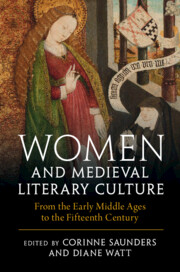Book contents
- Women and Medieval Literary Culture
- Women and Medieval Literary Culture
- Copyright page
- Contents
- Illustrations
- Contributors
- Acknowledgements
- Introduction
- I Patrons, Owners, Writers, and Readers in England and Europe
- II Circles and Communities in England
- III Health, Conduct, and Knowledge
- IV Genre and Gender
- V Women as Authors
- Chapter 18 Marie de France
- Chapter 19 Julian of Norwich
- Chapter 20 The Communities of The Book of Margery Kempe
- Chapter 21 Christine de Pizan
- Chapter 22 Beyond Borders
- General Index
- Index of Manuscripts
- References
Chapter 21 - Christine de Pizan
Women’s Literary Culture and Anglo-French Politics
from V - Women as Authors
Published online by Cambridge University Press: 28 July 2023
- Women and Medieval Literary Culture
- Women and Medieval Literary Culture
- Copyright page
- Contents
- Illustrations
- Contributors
- Acknowledgements
- Introduction
- I Patrons, Owners, Writers, and Readers in England and Europe
- II Circles and Communities in England
- III Health, Conduct, and Knowledge
- IV Genre and Gender
- V Women as Authors
- Chapter 18 Marie de France
- Chapter 19 Julian of Norwich
- Chapter 20 The Communities of The Book of Margery Kempe
- Chapter 21 Christine de Pizan
- Chapter 22 Beyond Borders
- General Index
- Index of Manuscripts
- References
Summary
This essay considers the influence and reception of the writings of Christine de Pizan, whose career was caught up in the Anglo-French conflict of the Hundred Yearsߣ War, as illustrated by her LߣEpistre dߣOthéa, a didactic treatise on chivalry and virtue, and her autobiographical LߣAdvision Christine. Warren explores the shifting significance of the Othéa during the fifteenth and sixteenth centuries, showing that Stephen Scropeߣs English translation reduced female agency and power, changes that reflected wider cultural anxieties concerning female lineage and virtue in the context of Lancastrian claims to the throne. The essay also explores Christineߣs connections to two other powerful women: Joan of Arc and Margaret of Anjou. By reworking Christineߣs treatments of women to reduce their political power and independent wisdom, translators of Christineߣs works also contained the political threats represented by powerful women. Strikingly, depictions of Christine as author shift her context from the court to the cloister, reaffirming traditionally gendered views of women even while her works continued to be circulated in England.
Keywords
- Type
- Chapter
- Information
- Women and Medieval Literary CultureFrom the Early Middle Ages to the Fifteenth Century, pp. 438 - 456Publisher: Cambridge University PressPrint publication year: 2023

